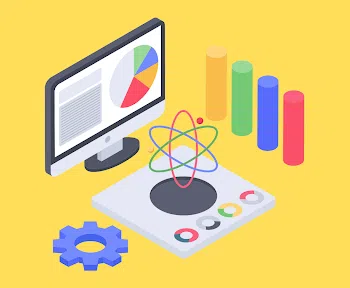How can businesses determine the efficacy of these efforts? Is there room for business improvement by refining specific metrics? The answers to these queries lie in A/B testing! This strategy allows businesses to tailor and optimize user experience (UX) specifically for their target audience.
What is A/B Testing?

“What works better – Option A or Option B?”
A/B testing is an Optimization technique for websites. It involves running experiments on two or more versions to find out which performs better and yields the most beneficial results for your business. This method is applied across various aspects such as website or mobile app pages, landing page designs, and advertising and content strategies.
Is A/B Testing Important?
Every business operates with a key aim – to maximize profits. In pursuit of this goal, they hire designers and developers to fine-tune their websites, striving to offer a superior customer experience. This process is vital as it facilitates an optimal environment for target users and drives up conversion rates.
In the modern era, data-driven decision-making is a common feature in the development and execution of business strategies. We can conduct the A/B testing for making decisions based on data-driven.
With websites becoming essential business tools so the primary task of a business is to ensure that website visitors become real customers rather than remaining just visitors. Therefore, A/B testing serves as a significant tool for making decisions based on the data, rather than relying on speculation or intuition.
Related Content: Explore more business ideas to maximize profits and ways to successfully execute product ideas using Minimum Viable Product (MVP)!
Harnessing the Power of A/B Testing:
01 | User Experience (UX) Enhancement
A/B testing is a tool to improve user experience. Visitors land on your website with a specific goal in mind to learn about a product or service, to make a purchase, or to acquire useful information on a certain topic.
However, challenges like hard-to-find CTA buttons or poor navigation while searching for desired products may create a less-than-ideal user environment. This can make it difficult for users to accomplish their goals. To avoid losing potential customers, it’s essential to use A/B testing to enhance your UX.
*Read Content: Looking to Hire a Freelance UX Designer?
02 | Conversion Rate Increase
Conversion metrics can involve product sales for e-commerce or lead generation for B2B businesses. Even minor changes on your website can lead to substantial increases in your business’s overall conversion rate. With A/B testing, you can identify what works (or doesn’t), aiding in boosting conversion rates.
You can employ A/B testing to redesign entire pages or just to make slight adjustments to certain elements. When you run an A/B test to verify a specific hypothesis, testing one change at a time allows you to discern what changes influence user behavior and which do not.
3 | Business Risk Reduction
In the same vein, elements proven ineffective through A/B testing can be eliminated. This helps businesses minimize wasted time, costs, and resources on unnecessary aspects, thus reducing business risks.
For instance, an A/B test might reveal that recent changes could lower your conversion rate. In such a scenario, you can halt modifications that might lead to negative outcomes, preventing substantial losses.
4 | Revenue Increase
Enhance User Experience ⬆
Increased Conversion Rate ⬆
Greater Customer Loyalty ⬆
Increased Repeat Purchases⬆
When UX improves through A/B testing, not only does the conversion rate increase, but customer loyalty toward the brand also amplifies. This typically leads to repeat purchases, creating a positive domino effect and influencing an increase in revenue.
A/B Testing Execution Method – A Step-by-Step Process

STEP 1: Research
The first step when planning an A/B test is to investigate the current operation status of your existing website. This process can start from quantitative research such as visitor numbers and page traffic, then move to qualitative research involving an in-depth study of session records.
-Quantitative Research
You can analyze which pages attract the most visitors, where users spend the most time, and which pages exhibit the highest bounce rates. This will help identify pages with the highest revenue potential or daily traffic.
Recommended tools: Google Analytics, Optimizely, etc.
-Qualitative Insights
Finding out which areas users spend the most time on and understanding behaviors like scrolling can help identify problem areas on the website.
Recommended tools: User surveys, session recording tools (for collecting visitor behavior data), etc.
STEP 2: Hypothesis Setting and Testing
Once data collection and analysis are complete, hypotheses are set and tested based on the research results.
–Hypothesis Setting: First, identify the Key Performance Indicators (KPIs) necessary to achieve your business objectives. Then, set up a hypothesis that needs to be true to improve these metrics and increase the conversion rate.
–Hypothesis Testing: After the hypothesis is set, test it for validity, its impact on your objectives, and ease of setup, among other parameters.
STEP 3: Create Versions
Having established hypotheses on what might be effective from a UX perspective in the existing version, you can now create multiple versions that incorporate these changes.
STEP 4: Run the Test
The requirements and objectives for your website will vary by business. Accordingly, you should clearly define your testing method and duration, and then execute the A/B test.
STEP 5: Analyze Test Results and Implement Changes
Once the testing is complete and then analyze the results. Consider factors such as the increase in numerical ratios, confidence levels, and the direct or indirect impact on other metrics.
After reviewing these figures, if a particular version is deemed successful in testing, then implement that version. If clear results are yet to be obtained, further testing can be considered.
Points to Consider When Conducting A/B Testing

✔ Overall business goals should connect to A/B testing.
Companies performing A/B testing should avoid the mistake of being so immersed in isolated aspects that they lose sight of the overall goals. In other words, while positive results in specific areas may seem to boost product and service metrics in the short term, the impact on achieving the final business goals could be minimal.
Therefore, it’s important to obtain meaningful metrics based on the understanding of the product and service, which can raise business KPIs while having a positive effect across the entire user experience.
How-To | A Systematic Approach to A/B Testing Success
First Step: Understanding the product and service
Seconds Step: Understanding KPIs and the correlation between different metrics
Third Step: Establishing an A/B testing strategy (Which metrics should be raised to achieve the product and service goals?)
Fourth Step: Reviewing the final objectives (What kind of impact will this have on the overall service and user experience?)
✔ A/B testing is not absolute.
A/B testing is a method to find a customized version that is optimized for a particular user group. In other words, it’s important to remember that the results obtained through A/B testing are not universal truths that apply to all situations.
For example, even if an A/B test targeting a specific user group shows that version A is more effective than B, version B could be more effective for a different user group.
Cases of Conversion Rate Improvement Through A/B Testing
Xerox
→ Improved the conversion rate of return visitors by 86.7% through web design enhancements
Xerox identified through data that the likelihood of a returning visitor making a purchase was 60% higher than that of a first-time visitor. With this knowledge, the team focused on improving the conversion rate of returning visitors.

Xerox improved the conversion rate of repeat visitors by 86.7% through web design improvements.(source)
By refining the homepage design with more intuitive visual elements and cleaner design, they were able to increase the conversion rate of return visitors by 86.7%!
Lasting
→ Improved conversion rate by 60% just by speeding up the registration process
Lasting is a relationship counseling program offered by Talkspace and a company that provides online/mobile therapy services. The team aimed to increase landing page conversion rates and complete registrations to improve user activation efficiency on the web.

Lasting improved the conversion rate by 60% just by making a very simple speed change in the service registration process. (source)
The registration process for Lasting includes a quiz as part of the process, allowing users to generate a personalized plan. The product team hypothesized that if they could reduce the long time spent responding to quizzes during the sign-up process, they could improve the conversion rate.
Through A/B testing, they were able to increase the conversion rate by 60% just by changing the timing of animations.
This was possible because shortening the length of the animations reduced the waiting time, making users feel as if the sign-up process had been simplified. Such minor changes, when tested via A/B testing, can greatly improve the conversion rate!
Readers.com
→ Increased the conversion rate (orders) of mobile visitors by 28% by changing the navigation of the mobile homepage
Readers.com, headquartered in Greenwood, Indiana, sells reading glasses online to customers in the United States and Canada. The product manager of this company wanted mobile users to have quick and easy access to all the most popular pages of this site. This was because the hamburger menu (三) might not be easy, depending on who the main customers of the business are.
So, they hypothesized, “If the main categories can be seen more easily than using the hamburger menu, mobile user orders can increase,” and performed an A/B test.

Readers.com increased the conversion rate of mobile visitors by 28% by changing the navigation of the mobile homepage. (source)
The result? The conversion rate of mobile users increased by 28%!
This is an example that shows that it is sometimes better to provide information about important categories and actions openly rather than hiding key information in dropdown navigations.
Remember, as mentioned earlier, A/B testing does not indicate an absolute fact, but shows the optimal solution when tested with a specific group!
Have you understood A/B testing now?
A/B testing is a test that must be conducted to convert visitors into customers. After completing A/B testing, the next step is UX/UI optimization to captivate customers.
Looking for freelancers for UX/UI optimization
Find one on Elancer!
Intrigued to discover more about the multifaceted world of IT business strategies beyond A/B testing?
Dive into our enriching IT Business Blog, exclusively curated for IT companies like yours!
Expand your horizons and empower your business with actionable insights, the latest trends, and innovative solutions.




